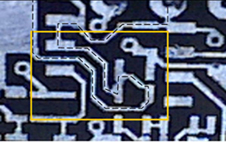Dr. Paul Robertson and his team are working on a new slant to an old sensing technology.
Flux-gate magnetic sensors have been around for many decades and are still used today for tasks such as geological surveys, aerospace instruments and even detecting submarines, as submarines disturb the Earth's magnetic field around them. These devices are usually quite large; assembled from coils wound on to magnetic cores. Paul and his team have developed new techniques to micro-fabricate flux-gate magnetic sensors, producing tiny versions of these sensors which are:
- extremely sensitive
- contained in a miniature package
- able to work over a wide frequency range
These properties allow the sensors to be used in a range of new applications including the measurement of electrical currents in circuits and the evaluation of the magnetic properties of materials - both of which can be achieved in a non-destructive manner.
One example of this is a magnetic microscope, in which the magnetic sensor is scanned over the surface of an item and the measured magnetic field is displayed as an image on a computer screen. Currently, magnetic microscopes are commercially available which use highly cooled superconducting sensors, but the sensors being developed here in the Department operate at room temperature - resulting in a much lower system cost.
Possible uses for such an instrument include surface defect detection in components and the development of ticketing, security cards, anti-counterfeiting devices and security features on bank notes, as all of these contain magnetic recording material. These pictures show images of current flow around a PCB track and part of George Washington's face - as printed in magnetic ink on a US dollar bill, scanned with a system built in the Department.


Paul and his team are currently developing this technology with a local company for use in a new product - a novel type of current probe for use by electronics engineers. The project is now in the production engineering phase. Other areas of interest would be welcomed.

